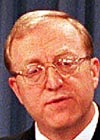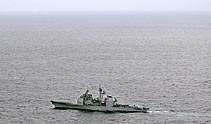 Rescued crew's plea: Find the others Rescued crew's plea: Find the others
 Incident likely ends commander's sterling career Incident likely ends commander's sterling career
 Navy withholding identity of civilians aboard sub Navy withholding identity of civilians aboard sub
 Surviving students return to Uwajima Surviving students return to Uwajima
 Public often given look at sub crews in action Public often given look at sub crews in action
 Lee Cataluna: Missing students brought joy during visit to local retailer Lee Cataluna: Missing students brought joy during visit to local retailer
 Tribute to the Missing Tribute to the Missing
 Video of yesterday's press conference with the crew of the Ehime Maru Video of yesterday's press conference with the crew of the Ehime Maru
By Susan Roth
Advertiser Washington Bureau
WASHINGTON — The crew of the USS Greeneville could not have helped the people aboard the Japanese fishing vessel the submarine rammed off the Honolulu coast, a Pentagon spokesman insisted yesterday.
 |
| Rear Adm. Craig Quigley said a submarine in high seas is "a lousy platform to recover people."
Associated Press |
High-ranking Japanese officials, former U.S. naval officers and maritime lawyers have sharply criticized the submarine crew, which seemed to watch survivors of Friday’s collision drifting in life rafts after their tuna trawler, the Ehime Maru, sank. Nine of the 35 on board are missing and presumed dead.
Rear Adm. Craig Quigley, the Pentagon spokesman, repeated the Navy’s claims that the seas were too high, at 4 to 6 feet, for the crew to open the submarine’s hatch and send life rafts or personnel.
Quigley said an attempt to pull the survivors aboard the submarine could have put them in greater jeopardy.
"A submarine in seas of 4 to 6 feet is a lousy platform to recover people from the water or bring rafts alongside," he said. "The hull of a Los Angeles-class submarine is basically round, smooth and slick by design. There’s only one small strip of nonskid material, running right down the center of the submarine, that allows any sort of traction at all."
The submarine came as close as 10 to 14 feet from one of the life rafts. If any of the rafts had slammed against the hull of the sub, some of the survivors could have been seriously injured or even killed, Quigley said.
"The submarine came to the surface, spotted the survivors in the rafts, radioed for help right away, with the full understanding that Coast Guard professional rescue personnel were literally on the way in minutes," he said. "They felt that the best course of action, so as to not put the survivors in any sort of a more dangerous situation than they were already in, was specifically to not go to get any closer to them and attempt to pull them on board the submarine. ...They saw the people in the life rafts, they seemed to be well in hand, and professional help was on the way."
 |
| The USS Port Royal yesterday continued the search off O‘ahu for the nine people missing in Friday’s collision of the submarine USS Greeneville and the Ehime Maru, a Japanese fishing boat used for training.
Associated Press |
In response to questions on the submarine’s use of sonar before the accident, Quigley insisted that passive, not active, sonar would be the best way for the submarine to have detected the fishing vessel.
Active sonar, which safety experts believe offers a clearer picture of the surface, would be blocked by a layer of warm water above the submarine, Quigley said.
Before executing a rapid-ascent exercise like the Greeneville’s on Friday, "I want to use the best sensor I have and that is passive sonar, not active sonar," he said.
Passive sonar, which is part of standard submarine tactics and procedures, is designed to find surface targets at considerable range from the submarine, he said. Quigley acknowledged that the system does have limitations, such as a lack of noise from the target or noise from the submarine itself.
But regardless of which sonar was in use, the submarine crew might not have been able to detect the smaller boat because of the angle of ascent, he said. The sonar system looks up vertically from the submarine. When the vessel ascends, the angle of the sonar would have shown a picture of the surface in back of the submarine, not right on top of it.
Meanwhile, for the first time since Friday’s accident, President Bush called Japanese Prime Minister Yoshiro Mori yesterday morning from the Oval Office. Bush said he apologized on behalf of the country and "assured him that we will do everything we can to try to find or recover the bodies" of the victims.
Asked about the criticism of the Greeneville’s crew, Bush said Mori "did not bring up that allegation to me. I have yet to hear all the facts from (Defense) Secretary (Donald) Rumsfeld, and I look forward to what he has to say."
White House spokesman Ari Fleischer said Bush and Mori spoke for about 10 minutes. Fleischer declined to say whether the president discussed Japan’s request that the United States raise the sunken ship from the bottom of the ocean. He said the Defense Department is handling the investigation and any potential salvage operation.
[back to top] |


